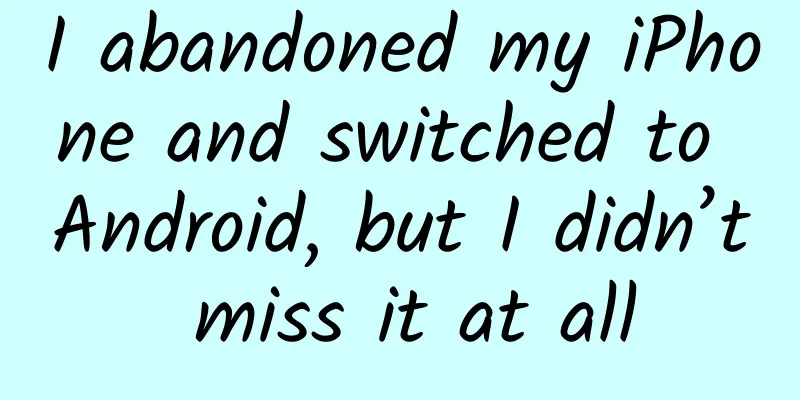I abandoned my iPhone and switched to Android, but I didn’t miss it at all

|
This is a self-narration of a 24-year-old boy, Seven, describing his feelings 120 days after switching from iPhone to Android. In the past few years of using Apple iPhone, every time a new iPhone is about to be released (about a month before), my iPhone will leave me, making it difficult for me to change phones. This was the case before the release of iPhone 5s (?1466), iPhone 6s, and iPhone X. Such experiences force me to make a choice every time: buy a thousand-yuan phone to wait for the new iPhone; or buy an iPhone from last year. The first two times I chose "last year's iPhone", but this year I tried something different. I didn't choose to buy a thousand-yuan phone to transition or buy an "old iPhone", but directly bought a domestic Android full-screen flagship (guess which model it is) as a long-term phone, which also means that a 5-year Apple fan has officially switched to the Android camp. I didn't feel sad when I switched from iPhone to Android At first, when I was planning to switch to Android, I was a little hesitant. I was worried that I would not be used to the Android system? I was worried that the Android camera would not be good? I was worried that the Android system would freeze? I was worried that the Android system would be unsafe... In short, I had a lot of concerns, but after three days of mental struggle and understanding the product, I finally made the decision to switch to Android. PS: I also prepared Plan B: If it doesn't work, I will sell this Android phone and switch back to iPhone. After using it for nearly 120 days, I feel relieved and proud because this domestic flagship is no worse than the iPhone X. Some current full-screen models (picture from GSMarena) Advantages compared to iPhone X:
The above are the advantages of using Android flagships compared to iPhone X. At the same time, I feel some of its shortcomings. Comparison of upper and lower foreheads of several full-screen models Compared with the shortcomings of iPhone X:
Seeing this, you may ask, is it meaningful to compare this Android flagship with iPhone X? Can it represent other Android flagships? Are they all the same or are they different? Since the second half of this year, domestic full-screen mobile phones have flooded in, ranging from high-end business flagships to youth options priced at RMB 1,000. This shows the high penetration rate and rapid growth of full-screen phones. If last year was the year of the dual-camera explosion in the mobile phone industry, then this year is definitely the year of the popularization of full-screen phones. Even if the "artificial intelligence" that is very popular in the technology industry is added to mobile phones, it may have to be put off until next year. Some current full-screen models (picture from GSMarena) So my point is: the domestic full-screen new phones that have been released so far are extremely homogeneous in appearance because they are equipped with 18:9 full-screen phones; you can even say that if you look at the front of the phone, you will think it is the same product. In addition, let alone the configuration, the problem of hardware homogeneity has never disappeared since the advent of smartphones. PS: Android phones: we are all the same. Comparison of upper and lower foreheads of several full-screen models Although the appearance and configuration of today's full-screen mobile phones are highly homogenized, each product still has its own target group (positioning) and different user demand solutions. Some focus on portrait photography, some focus on backlight photography, some focus on safety, some focus on business, and some focus on young people...PS: Android manufacturers: We are different. Therefore, the Android full-screen flagship I use can represent most of the indicators and features of the current Android camp, so the comparison between this Android flagship and iPhone X is representative, and can serve as a reference for students who are about to switch from iPhone to Android camp. |
<<: iOS mobile terminal interface encryption process (including single sign-on and expiration time)
>>: Optimizing memory usage to improve .NET performance
Recommend
The correct approach for content operations to conduct topic planning!
In fact, I have wanted to write an article about ...
The battle of billions of pixels: What are the mobile phone manufacturers competing for?
Recently, Xiaomi introduced Samsung's first 6...
ASUS's unique aesthetics of technology and art
On September 20, 2016, the ASUS Zenvolution new p...
Popular Science in Central Plains丨@Grandpa and Grandma, all the questions you care about about the new coronavirus vaccination are here!
Dahe.com (Reporter Shen Hua) At present, the COVI...
How much does it cost to be an agent for a fruit mini program in Dali?
How much does it cost to be an agent of Dali Frui...
From amazing to declining: Two years of Google Glass
Apart from Google Glass, there may be no other cu...
Detailed explanation of common methods of Android audio acquisition
Preface Android Audio Collection There are genera...
What are the functions of the garbage recycling mini program and how much does the garbage recycling mini program cost?
Since 2019, many cities in China have started to c...
The young man who wrote to Einstein opened up a new direction in quantum mechanics
Editor's Note Bose was born on January 1, 189...
How to create phenomenal variety show IPs such as Go Fighting and The Rap of China?
In an era where entertainment lasts forever, trad...
Science and technology are the core combat power! Xi Jinping talks about strengthening the military with science and technology
A strong country must have a strong military, and...
It changed color and also changed gender...
Welcome to Northern Plants. Today I will introduc...
Help you optimize mobile page performance from four aspects
With the development of mobile Internet, we need ...
Spring marketing, advanced branding strategies!
The annual "Spring Limited" marketing c...
iOS 9.1 version update: fix bugs and make details more intelligent
[[152890]] iOS 9.1 System Update Notes Apple upda...









